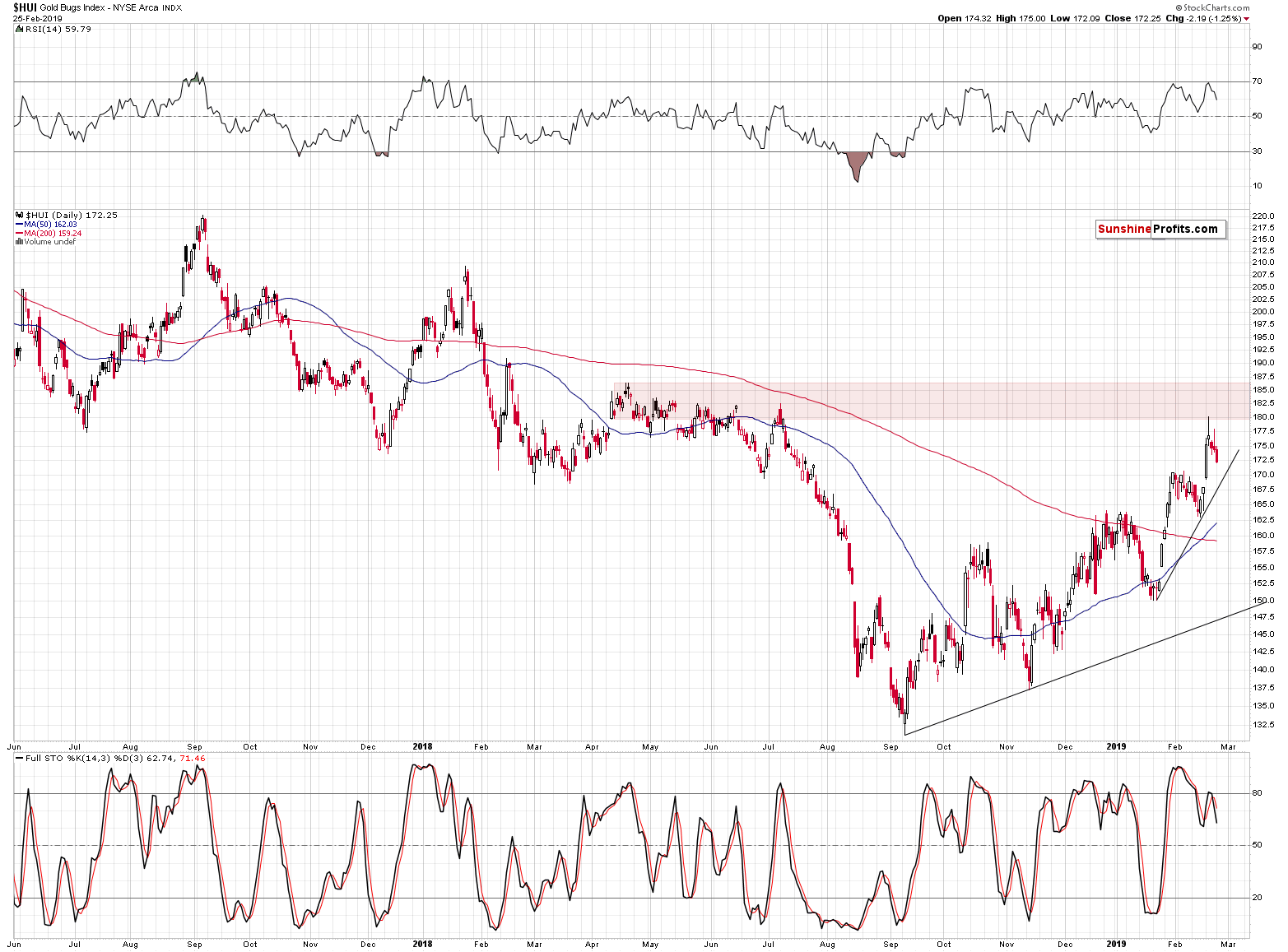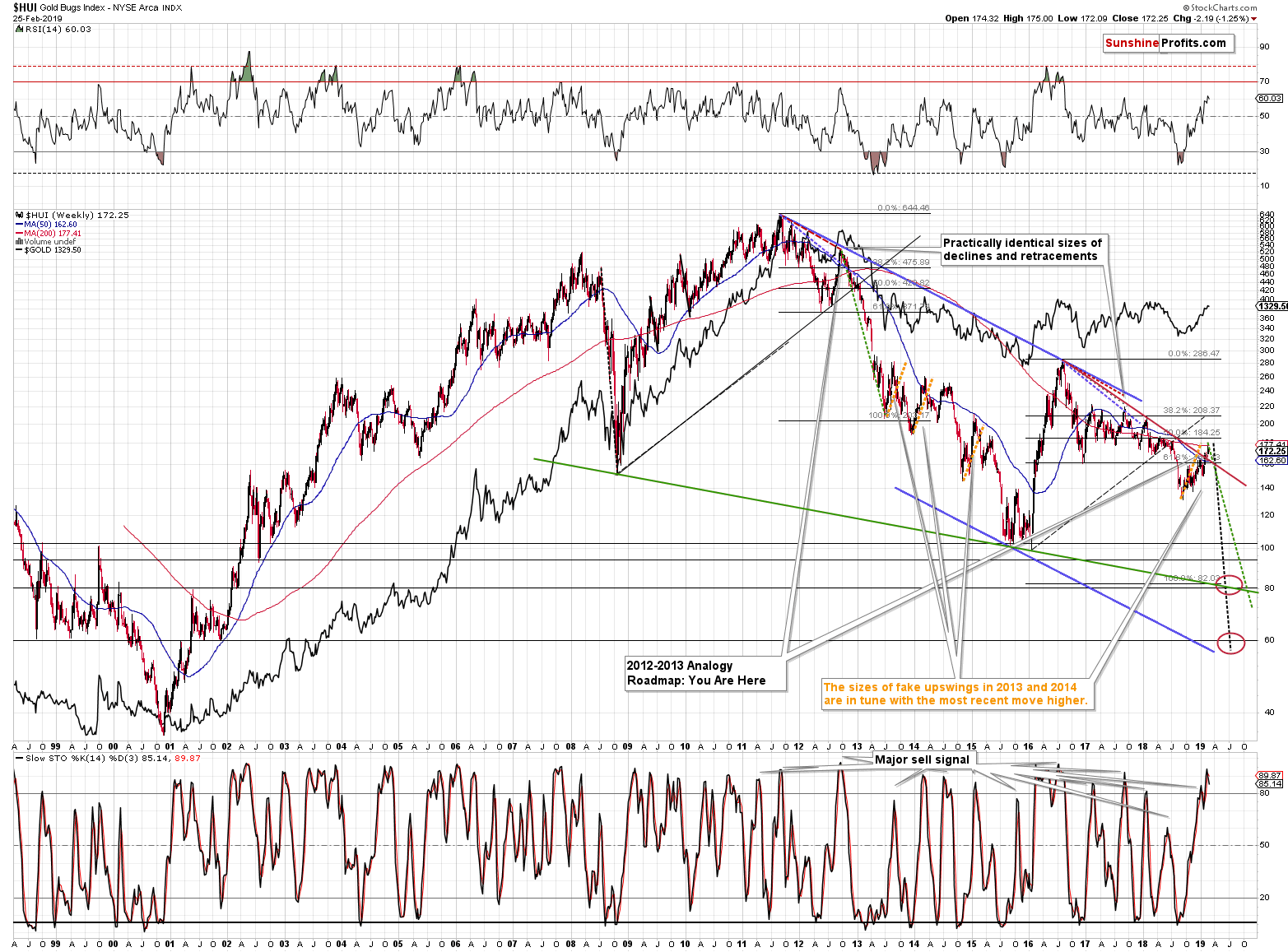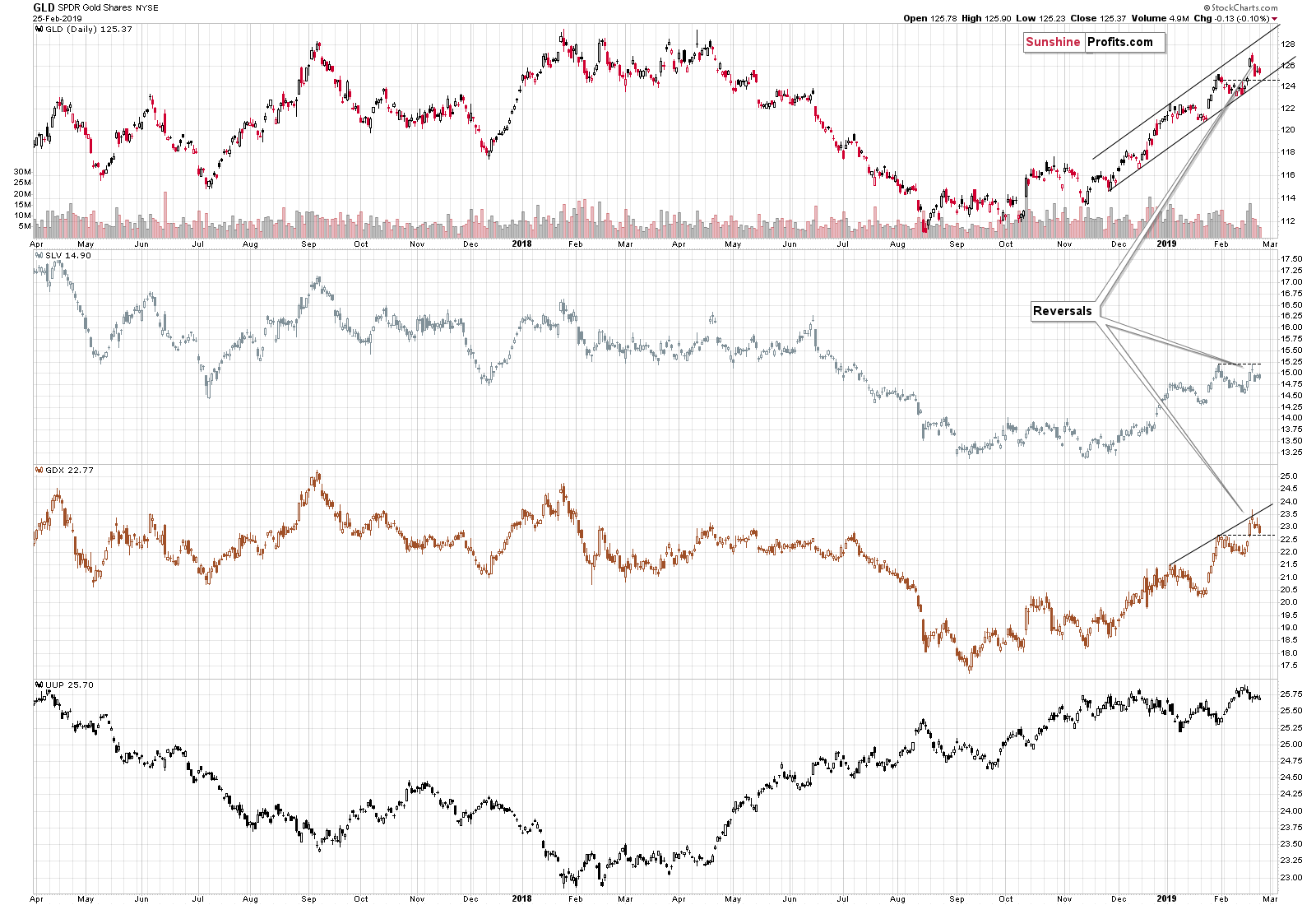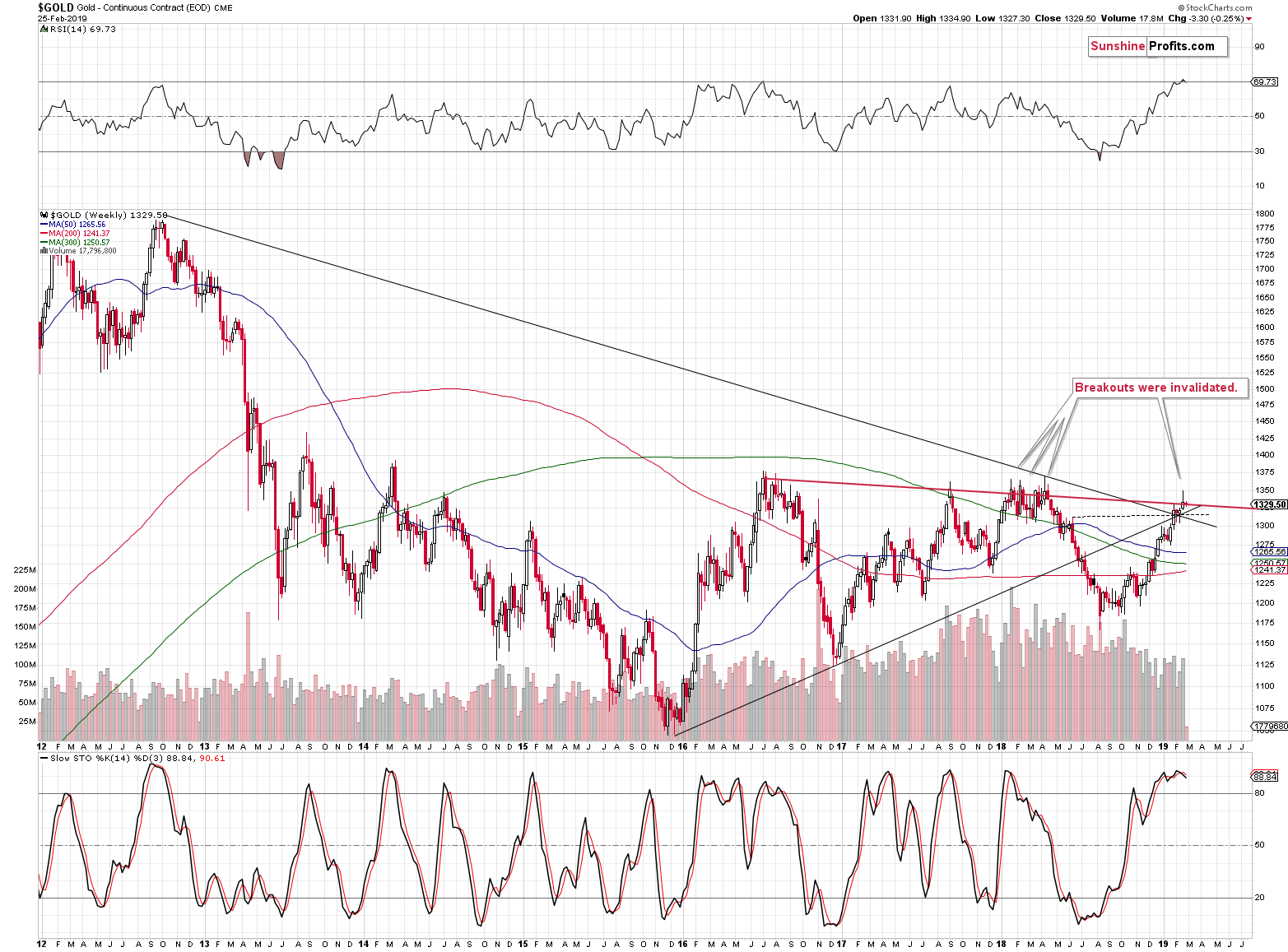Briefly: in our opinion, full (250% of the regular size of the position) speculative short position in silver is justified from the risk/reward perspective at the moment of publishing this Alert.
Gold and silver haven’t done much yesterday, but the mining stocks declined more visibly than the underlying metals. After outperforming on a short-term basis (and only in this way), miners are back in the underperformance mode. They remain above their January high, though, so the breakout above it was not invalidated, which has bullish implications. Which factor is the real one, and which one is the faker? Which way will miners move next?
The answer is that both factors are important, and this means that the short-term outlook is still rather unclear, at least based on the short-term charts. Yesterday’s action, however, suggests that the trends determined by the long-term charts are starting to play out. We wrote the following yesterday with regard to the analogy to 2016:
“But gold miners are rallying – just like in 2016!”
They may have moved higher – that’s true, but this move was definitely not at all as it was in 2016. At least not with regard to the direction. In 2016 gold mines truly soared and outperformed gold, leading it higher. This is definitely not happening right now. The move is relatively small (compared to what happened in 2016) and gold stocks underperform gold, instead of leading it higher. The more likely analogy to 2016 is likely to be the fakeness of the breakout that we just saw. In early 2016, the HUI Index briefly broke below the previous lows and started the powerful rally right after invalidating this fake move. The opposite appears likely right now – miners are likely to invalidate their recent breakout and then decline with vengeance.


The above-mentioned invalidation didn’t take place yet, but given the decisive underperformance that we saw yesterday and the decline by itself, it seems that we are seeing the beginning of the invalidation.
Comparing miners’ performance to the one of gold suggests the same thing.

Gold miners moved far above their January highs, but are now closer to invalidating the breakout above them than gold is. The implications are already bearish, but the key bearish confirmation will arrive when gold miners move below both: the January highs and the declining medium-term resistance/support line that we have on the long-term chart (marked with red).
Nothing really changed with regard to silver and gold, but we noticed something new with regard to the latter, so we will report it immediately.
Gold’s Invalidated Breakout
At the first sight, it appears that gold didn’t move to any important resistance last week and thus that the rally can easily continue. It turns out that it’s not entirely the case. Gold did move to the slightly declining, medium-term resistance line based on the 2016 and 2017 tops. The 2018 tops were higher, than the 2017 ones, so one may argue that they should be used for creating the resistance. It’s important to note, however, that none of the 2018 moves above this line held – they were all invalidated immediately, so, in a way, this line already worked several times.
And we saw something very similar last week – there was no weekly close above this line, but a one at it, however, there was an intraweek attempt to break higher. Last week’s attempt was invalidated just like all the attempts in 2018. This suggests that the top is in and that lower gold prices are even more likely to be seen in the following weeks.
Summary
Summing up, the precious metals sector seems to have reversed its course, but it’s too early to say that this is definitely the case right now. A lot will depend on this week’s signals with regard to short-term developments. The long-term charts continue to point to much lower gold, silver, and mining stock prices in the upcoming weeks and months. Based on the short-term indications, it seems too early to re-open the short positions in case of gold and mining stocks at this time, but it also seems that we are not far from this moment.
Please note that since the medium-term trend remains unaffected by the recent developments and the downside target remains intact (about $890 for gold), the precious metals market is likely to erase everything that it had gained in the last several days, weeks, and months, before THE bottom is in.
As always, we’ll keep you – our subscribers – informed.
To summarize:
Trading capital (supplementary part of the portfolio; our opinion): Full short positions (250% of the full position) in silver are justified from the risk/reward perspective with the following stop-loss orders and exit profit-take price levels:
- Gold: no position, but be prepared to enter the following position: profit-take exit price: $1,062; stop-loss: $1,357; initial target price for the DGLD ETN: $82.96; stop-loss for the DGLD ETN $39.87
- Silver: profit-take exit price: $12.32; stop-loss: $16.44; initial target price for the DSLV ETN: $47.67; stop-loss for the DSLV ETN $23.68
- Mining stocks (price levels for the GDX ETF): no position, but be prepared to enter the following position: profit-take exit price: $13.12; stop-loss: $24.17; initial target price for the DUST ETF: $76.87; stop-loss for the DUST ETF $15.47
Note: the above is a specific preparation for a possible sudden price drop, it does not reflect the most likely outcome. You will find a more detailed explanation in our August 1st Alert. In case one wants to bet on junior mining stocks’ prices (we do not suggest doing so – we think senior mining stocks are more predictable in the case of short-term trades – if one wants to do it anyway, we provide the details), here are the stop-loss details and target prices:
- GDXJ ETF: profit-take exit price: $17.52; stop-loss: $35.67
- JDST ETF: initial target price: $143.87 stop-loss: $30.97
Long-term capital (core part of the portfolio; our opinion): No positions (in other words: cash)
Insurance capital (core part of the portfolio; our opinion): Full position
Important Details for New Subscribers
Whether you already subscribed or not, we encourage you to find out how to make the most of our alerts and read our replies to the most common alert-and-gold-trading-related-questions.
Please note that the in the trading section we describe the situation for the day that the alert is posted. In other words, it we are writing about a speculative position, it means that it is up-to-date on the day it was posted. We are also featuring the initial target prices, so that you can decide whether keeping a position on a given day is something that is in tune with your approach (some moves are too small for medium-term traders and some might appear too big for day-traders).
Plus, you might want to read why our stop-loss orders are usually relatively far from the current price.
Please note that a full position doesn’t mean using all of the capital for a given trade. You will find details on our thoughts on gold portfolio structuring in the Key Insights section on our website.
As a reminder – “initial target price” means exactly that – an “initial” one, it’s not a price level at which we suggest closing positions. If this becomes the case (like it did in the previous trade) we will refer to these levels as levels of exit orders (exactly as we’ve done previously). Stop-loss levels, however, are naturally not “initial”, but something that, in our opinion, might be entered as an order.
Since it is impossible to synchronize target prices and stop-loss levels for all the ETFs and ETNs with the main markets that we provide these levels for (gold, silver and mining stocks – the GDX ETF), the stop-loss levels and target prices for other ETNs and ETF (among other: UGLD, DGLD, USLV, DSLV, NUGT, DUST, JNUG, JDST) are provided as supplementary, and not as “final”. This means that if a stop-loss or a target level is reached for any of the “additional instruments” (DGLD for instance), but not for the “main instrument” (gold in this case), we will view positions in both gold and DGLD as still open and the stop-loss for DGLD would have to be moved lower. On the other hand, if gold moves to a stop-loss level but DGLD doesn’t, then we will view both positions (in gold and DGLD) as closed. In other words, since it’s not possible to be 100% certain that each related instrument moves to a given level when the underlying instrument does, we can’t provide levels that would be binding. The levels that we do provide are our best estimate of the levels that will correspond to the levels in the underlying assets, but it will be the underlying assets that one will need to focus on regarding the signs pointing to closing a given position or keeping it open. We might adjust the levels in the “additional instruments” without adjusting the levels in the “main instruments”, which will simply mean that we have improved our estimation of these levels, not that we changed our outlook on the markets. We are already working on a tool that would update these levels on a daily basis for the most popular ETFs, ETNs and individual mining stocks.
Our preferred ways to invest in and to trade gold along with the reasoning can be found in the how to buy gold section. Additionally, our preferred ETFs and ETNs can be found in our Gold & Silver ETF Ranking.
As a reminder, Gold & Silver Trading Alerts are posted before or on each trading day (we usually post them before the opening bell, but we don't promise doing that each day). If there's anything urgent, we will send you an additional small alert before posting the main one.
Thank you.
Sincerely,
Przemyslaw Radomski, CFA
Editor-in-chief, Gold & Silver Fund Manager




